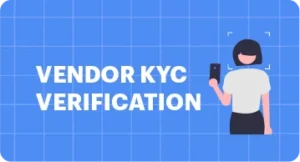cKYC Under RBI’s High-Risk Lens: What It Implies and the Video KYC Way Forward
Introduction
In the world of financial services, the Know Your Customer (KYC) process stands as a guardian of integrity, transparency, and regulatory compliance. At the heart of this process lies Centralized KYC (cKYC), a system that streamlines customer onboarding for banks and financial institutions. However, the recent decision by the Reserve Bank of India (RBI) to label cKYC as high-risk has prompted a reevaluation of its implications for businesses and consumers. Alongside this, we’ll explore a promising alternative – Video KYC.
What is KYC?
KYC, short for Know Your Customer, is a cornerstone of the financial industry. It involves the collection of customer information and documents to verify their identity and ensure compliance with regulatory standards.
What is cKYC?
Centralized KYC (cKYC) is a system that allows financial institutions to access a centralized repository of KYC records, reducing redundancy and enhancing efficiency in customer onboarding.
What is Video KYC?
Video KYC is an innovative alternative to the traditional cKYC process. It employs video calls to verify customer identities and documents, offering a more efficient and secure means of conducting KYC.
Why did the RBI tag cKYC as high-risk?
The RBI’s decision to classify cKYC as high-risk is based on concerns regarding vulnerabilities within the system, particularly its susceptibility to fraudulent activities.
Implications of RBI’s High-Risk Tag on cKYC
-
Increased risk of fraud and financial crime
The reclassification of cKYC as high-risk spotlights potential vulnerabilities that could be exploited by fraudsters, posing a significant threat to the integrity of financial institutions and their customers. -
Reduced customer onboarding rates
Perceptions of increased risk linked to cKYC may lead to a decrease in customer onboarding rates. Prospective customers might hesitate to engage with institutions using cKYC, potentially slowing growth. -
Increased costs and complexity for businesses
For financial institutions, the high-risk tag on cKYC equates to higher operational costs and increased administrative complexities. Implementing additional security measures to mitigate risks can strain resources. -
Reduced customer satisfaction
Cumbersome cKYC processes can lead to frustration and dissatisfaction among customers. A seamless onboarding experience is crucial for establishing trust and loyalty.
Video KYC as an Alternative
Benefits of Video KYC
- Improved security and fraud prevention: Real-time verification reduces the risk of fraudulent activities.
- Faster and more convenient customer onboarding: The process is streamlined, allowing for quicker onboarding without compromising security.
- Reduced costs and complexity for businesses: Video KYC eliminates the need for physical documentation and minimizes administrative overhead.
- Improved customer satisfaction: Convenience and efficiency enhance customer experience and trust.
How does video KYC work?
Video KYC uses secure video calls to verify customer identities and documents. Trained agents guide customers through the process, ensuring compliance with regulatory standards.
Best practices for Video KYC
- Ensure a stable and secure internet connection for both parties.
- Verify the authenticity of documents through advanced verification tools.
- Conduct thorough training for agents to handle Video KYC processes effectively.
Conclusion
In response to the RBI’s classification of cKYC as high-risk, businesses and consumers alike must consider alternatives. Video KYC emerges as a promising solution, offering enhanced security, convenience, and cost-effectiveness. Embracing this technology safeguards against risks and elevates the customer experience. The future of KYC is evolving, and Video KYC is leading the way toward a more secure and efficient onboarding process for all stakeholders.
Recommendations for Businesses and Consumers
For Businesses:
- Embrace Video KYC: Consider implementing Video KYC as a secure and efficient alternative to traditional cKYC. Evaluate reputable Video KYC providers like MSB Docs to streamline the onboarding process.
- Invest in Training: Ensure that your staff is well-trained in using Video KYC technology to provide a seamless experience to customers.
- Stay Compliant: Keep abreast of regulatory changes and ensure that your Video KYC processes remain compliant with evolving standards.
- Focus on Customer Experience: Use Video KYC as an opportunity to enhance customer satisfaction by offering a convenient, secure, and efficient onboarding experience.
For Consumers:
- Be Informed: Understand the KYC process your financial institution uses. If Video KYC is offered, consider its benefits in terms of convenience and security.
- Ensure Security: Protect your personal information during Video KYC sessions by using secure networks and devices.
- Provide Accurate Information: Be diligent in providing accurate details and documentation during the KYC process to expedite onboarding.
- Voice Concerns: If you have concerns or questions about Video KYC, don’t hesitate to voice them to your financial institution. They should be able to address your queries.
Future Outlook for Video KYC
The future of KYC is undoubtedly undergoing a transformation, and Video KYC is at the forefront of this evolution. As technology continues to advance and regulations adapt to accommodate these changes, Video KYC is likely to become the industry standard. The benefits it offers, including enhanced security, reduced costs, and improved customer satisfaction, make it an attractive choice for businesses in various sectors beyond finance.
Additionally, the integration of artificial intelligence and machine learning into Video KYC processes will further enhance its capabilities. These technologies will enable automated document verification, real-time facial recognition, and behavioral analysis, making the process even more secure and efficient.
In conclusion, the RBI’s classification of cKYC as high-risk has prompted a necessary shift in the way we approach customer onboarding and identity verification. Video KYC has emerged as a robust alternative, addressing the vulnerabilities associated with cKYC while offering a host of benefits for both businesses and consumers. Its future looks promising, promising a more secure, efficient, and user-friendly KYC process.
About MSB Docs VKYC Offering
MSB Docs is at the forefront of the Video KYC revolution, providing a secure and reliable solution for businesses across industries. Our Video KYC offering combines cutting-edge technology with user-friendly interfaces, ensuring a seamless onboarding experience. With a commitment to compliance and data security, MSB Docs empowers businesses to embrace the future of KYC with confidence.
In this ever-evolving landscape, choosing the right Video KYC solution is crucial. MSB Docs offers a robust platform designed to meet the unique needs of your business while prioritizing security and customer satisfaction.
As the financial industry and beyond continue to adapt to the changing regulatory environment, Video KYC remains a beacon of innovation and efficiency. With MSB Docs as your partner, you can navigate this transformation with ease, ensuring that your KYC processes are not only compliant but also poised for a bright and secure future.
Delved into cKYC under RBI’s high-risk lens? Ready to navigate the future with Video KYC compliance? Take the next step with MSB Docs. Request a demo or book your free trial today.
FAQs
1. Is cKYC still a viable option for customer onboarding despite the RBI’s high-risk classification?
While cKYC remains a valid method for customer onboarding, the RBI’s high-risk designation indicates increased vulnerabilities. Considering this, businesses are exploring Video KYC as a more secure and efficient alternative.
2. What specific vulnerabilities in cKYC led to its high-risk classification by the RBI?
The RBI has not provided specific details, but the high-risk classification suggests concerns over potential vulnerabilities related to identity verification and fraud within the cKYC system.
Unlock the guidelines for AML/CFT compliance in the insurance sector as prescribed by IRDAI in our informative post.
3. How does Video KYC enhance customer satisfaction compared to traditional cKYC processes?
Video KYC offers a more convenient and efficient onboarding experience. Customers can complete the process from the comfort of their homes, reducing the need for physical visits to bank branches, thus improving overall satisfaction.
4. Are there any regulatory challenges associated with adopting Video KYC in response to RBI’s classification of cKYC as high-risk?
While Video KYC is gaining acceptance, regulatory compliance is crucial. Businesses must ensure that their Video KYC processes adhere to RBI guidelines and other relevant regulations to avoid any compliance issues.
5. What are some best practices for businesses looking to implement Video KYC as an alternative to cKYC?
Key best practices include ensuring a stable and secure internet connection during video calls, using advanced verification tools to authenticate documents, and providing comprehensive training to staff involved in Video KYC processes to ensure efficient and compliant onboarding.





